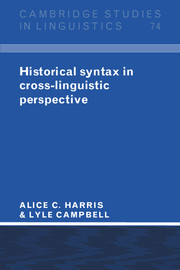Book contents
- Frontmatter
- Contents
- Preface
- List of abbreviations
- 1 Introduction
- 2 The history of historical syntax: major themes
- 3 Overview of a theory of syntactic change
- 4 Reanalysis
- 5 Extension
- 6 Language contact and syntactic borrowing
- 7 Processes that simplify biclausal structures
- 8 Word order
- 9 Alignment
- 10 On the development of complex constructions
- 11 The nature of syntactic change and the issue of causation
- 12 Reconstruction of syntax
- Appendix
- Notes
- References
- Index of languages and language families
- Index of scholars
- Index of subjects
7 - Processes that simplify biclausal structures
Published online by Cambridge University Press: 05 June 2012
- Frontmatter
- Contents
- Preface
- List of abbreviations
- 1 Introduction
- 2 The history of historical syntax: major themes
- 3 Overview of a theory of syntactic change
- 4 Reanalysis
- 5 Extension
- 6 Language contact and syntactic borrowing
- 7 Processes that simplify biclausal structures
- 8 Word order
- 9 Alignment
- 10 On the development of complex constructions
- 11 The nature of syntactic change and the issue of causation
- 12 Reconstruction of syntax
- Appendix
- Notes
- References
- Index of languages and language families
- Index of scholars
- Index of subjects
Summary
Introduction
Our goal in this chapter is the presentation of universal characterizations of some of the diachronic processes that turn biclausal constructions into monoclausal ones. We approach this goal first by describing one such process from the point of view of several languages, then generalizing about the form of this process. We then examine a different process, and make generalizations about its form. Finally we analyze a large category of processes and end the chapter with a statement of general principles governing all the changes examined within the chapter.
To this end, section 7.2 discusses processes that derive from cleft clauses containing pragmatic markers. In section 7.3 we describe the transition from quotation constructions to structures involving a quotative marker. A process that derives a variety of periphrastic expressions of verbal categories is discussed in section 7.4. All three processes considered here are types of reanalysis; in section 7.5 we state general principles governing changes of biclausal to monoclausal structures.
Highlighting constructions
We examine in this section cross-linguistic evidence concerning one origin of highlighting – the use of particles to mark focus or topic. This is not an exhaustive inventory of sources of such markers; instead we deal in some detail with a single common pathway of development, derivations found in a wide variety of unrelated languages.
- Type
- Chapter
- Information
- Historical Syntax in Cross-Linguistic Perspective , pp. 151 - 194Publisher: Cambridge University PressPrint publication year: 1995

